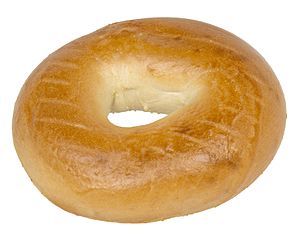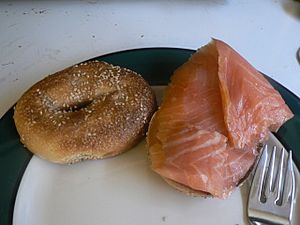New York style bagel facts for kids

A plain New York style bagel
|
|
| Type | Bagel |
|---|---|
| Place of origin | United States |
| Region or state | New York City |
| Main ingredients | Barley malt |
| Similar dishes | Montreal-style bagel |
The New York style bagel is a special kind of bagel first made in the United States. It comes from the Jewish community in New York City. This bagel's story goes back to the bagels made by Jewish people in Poland.
A traditional New York style bagel is usually bigger and thicker than bagels you might find in a store. It's also larger than a Montreal-style bagel. These bagels have grown in size over time. In 1915, they weighed about 3 ounces, but by 2003, they were often 6 ounces.
Contents
The Story of New York Bagels
In the 1800s, many Jewish people from Poland and Eastern Europe came to New York City. They brought their traditional foods with them. These foods included things like challah (a braided bread), brisket (a type of meat), knishes (baked or fried dough with fillings), and bagels.
For many years, bagels were mostly known within the Jewish community. But there, they were very popular! Bagels became so loved that groups were formed for bagel bakers. One group, called Bagel Bakers Local 338, had over 300 bagel makers in Manhattan by the early 1910s.
New York-style bagels were the first kind of bagel available in the United States. While many cities around the world now have their own bagel styles, the idea of the bagel started in New York City. It began on the Lower East Side of Manhattan. Bagels were created as a tasty, filling, and cheap food for Jewish immigrants living there in the 1800s.
The bagel quickly became popular across New York City and then spread throughout the United States. Soon, different versions of bagels were made all over the world. The modern bagel we know today really started in New York City, especially within its Jewish community.
Starting in the 1960s, more and more people outside the Jewish community began to enjoy New York style bagels. Over the years, these bagels grew in size. They went from about 3 ounces to the 6 ounces you often see today.
What Makes Them Special?
Many people say that the unique taste and texture of a real New York bagel comes from the New York City tap water. They believe the water has special minerals that make a better bagel. Specifically, New York water has low amounts of calcium and magnesium, which makes it "softer."
New York City's water also has a lot of "total dissolved solids" (TDS), which are tiny bits of sediment. This also makes the water softer. Some people think this soft water helps make the gluten in the bagel dough stronger. This strength helps create the chewy inside and crispy outside that New York style bagels are known for.
Christopher Pugliese, who owns a popular bagel shop in the East Village, Manhattan, agrees. He says the special taste of a New York style bagel is "100% the water."
However, the water might not be the only secret. Josh Polack, who owns a bagel shop in Denver, Colorado, tries to make his water like New York's. He says:
It’s not just the water that makes a good bagel, but it’s a number of things that have been done the same way for almost 200 years. You can take one of the processes out; you can take the water out, and keep everything else true to the tradition and still have a really awesome bagel. But if you take out the water, and the oven that they traditionally use, you’re not going to get the same bagel.
This means that many steps in the traditional bagel-making process are important, not just the water.
How New York Bagels Are Made
A New York style bagel is always boiled in water. This water has barley malt added to it. The barley malt gives the bagel its special taste, texture, and slightly leathery skin.
After boiling, bagels are often topped with different things. Popular traditional toppings include sesame seeds, poppy seeds, dried onion, or garlic. Some bagels are topped with "everything bagel" seasoning, which is a mix of these. Others are left plain or brushed with an egg wash.
There are also newer flavors like cinnamon raisin and other sweet bagels. These started in the 1950s and 1960s. Some New Yorkers and Jewish community members don't consider these traditional. They have even been called a shonda, which means a disgrace or shame.
Next, the bagels are placed on special wooden boards covered with burlap. These boards are usually wet or sometimes coated with cornmeal or semolina. The bagels are then baked in a hot oven for a few minutes. Halfway through baking, the baker flips the bagels over and removes the boards. Finally, the bagels are taken out of the oven and allowed to cool.
How to Enjoy a New York Bagel
A fresh New York style bagel is traditionally never toasted. Many people believe toasting takes away from its perfect texture.
Bagel with Lox and Schmear

A very popular way to eat a New York bagel is with lox and schmear. Lox is thinly sliced cured salmon, and schmear is a creamy spread, usually cream cheese.
According to food historian Gil Marks, Jewish people in New York City created this meal in the 1930s. It was a kosher (following Jewish dietary laws) version of Eggs Benedict. Eggs Benedict contains pork and mixes dairy and meat, which are not allowed in Jewish dietary law. So, the bagel with lox and schmear became a delicious alternative.
This combination was unique to New York City's Jewish community. In Poland, Jewish communities traditionally spread schmaltz (chicken fat) on their bagels. They also ate bagels with cholent (a slow-cooked stew) or other soups, or as a dinner roll.

